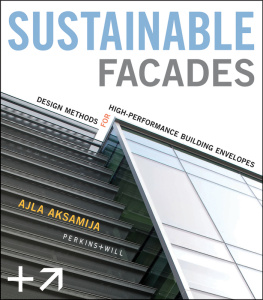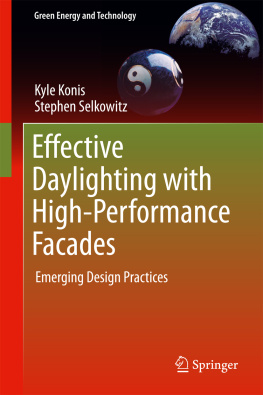Cover image: Benjamin Benschneider/OTTO
Cover design: Michael Rutkowski
This book is printed on acid-free paper.
Copyright 2013 by Ajla Aksamija and Perkins+WillAll rights reserved.
Published by John Wiley & Sons, Inc., Hoboken, New Jersey
Published simultaneously in Canada
No part of this publication may be reproduced, stored in a retrieval system, or transmitted in any form or by any means, electronic, mechanical, photocopying, recording, scanning, or otherwise, except as permitted under Section 107 or 108 of the 1976 United States Copyright Act, without either the prior written permission of the Publisher, or authorization through payment of the appropriate per-copy fee to the Copyright Clearance Center, 222 Rosewood Drive, Danvers, MA 01923, (978) 750-8400, fax (978) 646-8600, or on the web at www.copyright.com . Requests to the Publisher for permission should be addressed to the Permissions Department, John Wiley & Sons, Inc., 111 River Street, Hoboken, NJ 07030, (201) 748-6011, fax (201) 748-6008, or online at www.wiley.com/go/permissions .
Limit of Liability/Disclaimer of Warranty: While the publisher and author have used their best efforts in preparing this book, they make no representations or warranties with the respect to the accuracy or completeness of the contents of this book and specifically disclaim any implied warranties of merchantability or fitness for a particular purpose. No warranty may be created or extended by sales representatives or written sales materials. The advice and strategies contained herein may not be suitable for your situation. Neither the publisher nor the author shall be liable for damages arising herefrom.
For general information about our other products and services, please contact our Customer Care Department within the United States at (800) 7622974, outside the United States at (317) 5723993 or fax (317) 5724002.
Wiley publishes in a variety of print and electronic formats and by print-on-demand. Some material included with standard print versions of this book may not be included in e-books or in print-on-demand. If this book refers to media such as a CD or DVD that is not included in the version you purchased, you may download this material at http://booksupport.wiley.com . For more information about Wiley products, visit www.wiley.com .
Library of Congress Cataloging-in-Publication Data:
Aksamija, Ajla.
Sustainable facades : design methods for high-performance building envelopes / Ajla Aksamija, Ph.D., Perkins+Will.
pages cm
Includes bibliographical references and index.
ISBN 978-1-118-45860-0 (cloth); ISBN 978-1-118-54964-3 (ebk); ISBN 978-1-118-54971-1 (ebk); ISBN 978-1-118-54975-9 (ebk)
1. Facades--Design and construction. 2. Exterior walls--Design and construction. 3. Sustainable design. I. Title.
TH2235.A426 2013
729'.1--dc23
2012037882
Printed in the United States of America
10 9 8 7 6 5 4 3 2 1
Figure Credits
Figure 2-6a: Jeff Green
Figure 2-6b: Jeff Green
Figure 2-20: Steinkamp Photography
Figure 2-21: Steinkamp Photography
Figure 3-19: Nick Merick Hedrich Blessing
Figure 3-21: Nick Merick Hedrich Blessing
Figure 5-4: Steinkamp Photography
Figure 5-5: Steinkamp Photography
Figure 5-6a: Steinkamp Photography
Figure 5-6b: Steinkamp Photography
Figure 5-9: Steinkamp Photography
Figure 5-10: Steinkamp Photography
Figure 5-11: Steinkamp Photography
Figure 5-15: Benjamin Benschneider
Figure 5-17: Benjamin Benschneider
Figure 5-20: Benjamin Benschneider
Figure 5-21: Benjamin Benschneider
Figure 5-22: Benjamin Benschneider
Figure 5-23: Benjamin Benschneider
Figure 5-24: Benjamin Benschneider
Figure 5-25: Benjamin Benschneider
Figure 5-67: Charles Smith
Figure 5-68: Charles Smith
Figure 5-69: Charles Smith
Figure 5-72: Charles Smith
Figure 5-73: Charles Smith
Figure 5-76: Charles Smith
Figure 5-77: Charles Smith
Figure 5-80: Christopher Barnes ChristopherBarnes.com
Figure 5-82: Christopher Barnes ChristopherBarnes.com
Figure 5-83: Christopher Barnes ChristopherBarnes.com
Figure 5-84: Christopher Barnes ChristopherBarnes.com
Figure 5-87: Christopher Barnes ChristopherBarnes.com
Acknowledgments
I would like to acknowledge Bill Schmalz, RK Stewart, and Bruce Toman for their input, comments, and tremendous support during the writing of this book. Also, project team members of the featured case studies were crucial in providing the necessary documentation and comments, and I am deeply grateful for their involvement: Curt Behnke, Pat Bosch, Ryan Bragg, Alejandro Bragner, Eric Brossy de Dios, Jane Cameron, Matthew Crummey, Patrick Cunningham, Anthony Fieldman, James Giebelhausen, Patrick Glenn, Andrew Goetze, David Hansen, Scott Kirkham, Devin Kleiner, Aki Knezevic, Richard Miller, Tom Mozina, Michael Palmer, Camila Querasian, Deborah Rivers, Bryan Schabel, Dan Seng, Gary Shaw, Calvin Smith, Ron Stelmarski, Angel Suarez, Jolly Thulaseedas, Deepa Tolat, Ashwin Toney, and Mark Walsh. I would also like to thank Wajdi Abou-Izzeddine (The Dar Group) for his valued input. My research assistants, Negin Beyhaghi and Abul Abdullah, deserve special recognition for their assistance: Negin for collecting information about some of the case studies in the book, and Abul for preparation of some of the diagrams. Kathryn Bourgoine, Donna Conte, Danielle Giordano, and the Wiley production team deserve special recognition for their input during the production of this book.
Lastly, I would like to acknowledge Zlatan and Nur Aksamija for their undivided love and support.
Introduction
Buildings, as the largest users of energy in our society, are also our greatest opportunity for energy conservation and protection of the environment. The rapidly growing world energy use has raised global concerns over continued depletion of energy resources and their negative environmental impacts. Current predictions show that this growing trend will continue.
The facade is one of the most significant contributors to the energy budget and the comfort parameters of any building. As energy and other natural resources continue to be depleted, it has become clear that technologies and strategies that allow us to maintain our satisfaction with the interior environment while consuming fewer of these resources are major objectives for contemporary facade designs.
This book focuses on the strategies and approaches for designing sustainable, high-performance building facades, and provides technical guidance for architects and designers. Building facades act as barriers between the interior and exterior environment. To provide building occupants with a comfortable and safe environment, a facade must fulfill many functions, such as:
- Provision of views to the outside
- Resistance of forces from wind loads
- Bearing its own weight
- Implementation of daylighting strategies to minimize use of artificial lighting
- Protection from solar heat gain
- Protection from noise
- Resistance to rainwater and moisture penetration
Control of physical environmental factors (heat, light, sounds) must be considered during the design process, as must design strategies that improve occupant comfort (thermal, visual, acoustic, and air quality). Therefore, sustainable facades must block adverse external environmental effects and maintain internal comfort conditions with minimum energy consumption. The location and climate thus are crucial factors in selecting appropriate design strategies for sustainable facades.
Next page











